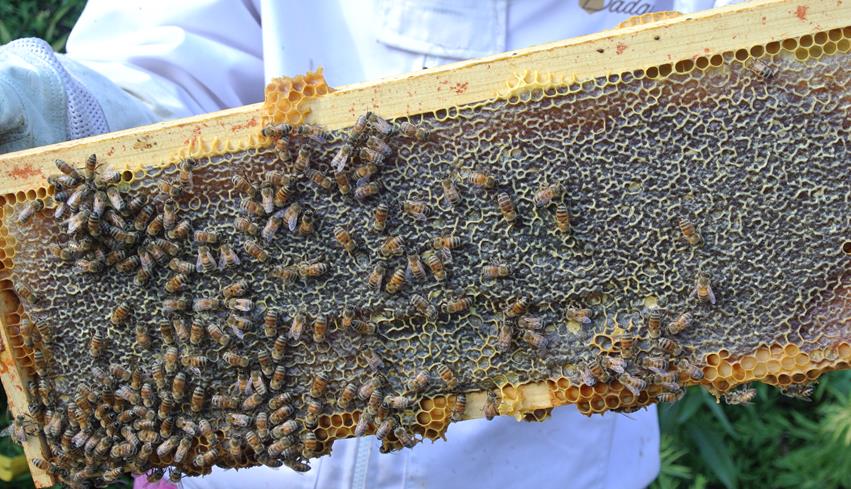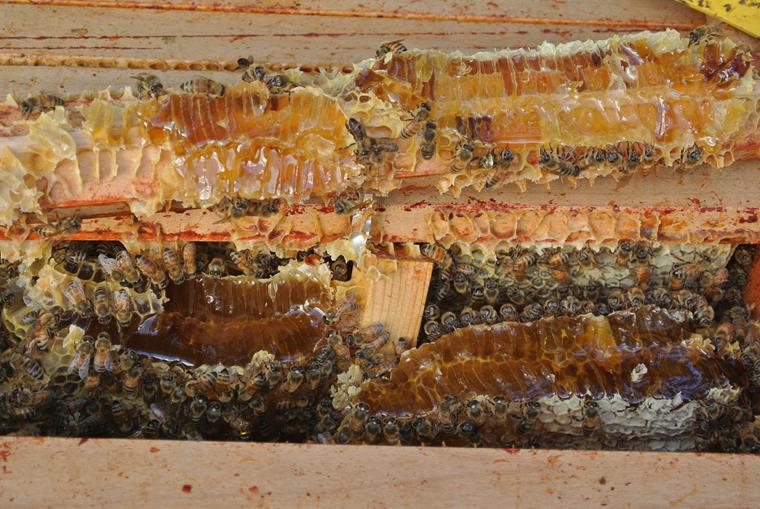A little history from Wikipedia: Labor Day is a celebration of the American labor movement – commemorating the social and economic achievements of workers. Dating back to 1882, this is “relatively new” holiday (you know versus Christmas) but today it is much more about the end of summer, retiring white fashion, back to school sales and barbeques. Nonetheless, let us observe the real labors on my block, the honeybees. In addition to this human holiday, National Honeybee Day is another great day to say thank you. Below is an endearing “Thank You” I received from a friend’s child after giving him some honey. He is pretty sure he spotted some of my bees in his yard (~ 20 miles away) and was quite excited.

This hive check intention was to pull frames for Honey Harvest 2013. I have a busy month and a half ahead of me and don’t want to “overwait” (read procrastinate anymore). I also want to feed the hives a bit before late fall (see post on feeding with syrup) and the girls will need time to store the syrup away, even though I am not greedy when taking honey. There are quite a few items for consideration when harvesting.
- Geographical location: get connected
- Honey water content: Honey is ready when it is at or below 18%
- Scale or number of hives
- Plan for removing bees from the frames: brush/shake off, fumigate/deter, bee escape, bee blower, abandon
- Method to extract honey: crush comb vs. centrifuge vs. cut comb vs. melting
- Type of honey: harvesting at key times of year to capture a specific honey varietal or once towards the end
- Health of hive: each year I have had a hive that doesn’t have surplus honey for me to remove
- Hive style: traditional vs. Warre vs. Top bar frames might not succeed in the variations types of extraction
- Destination for wax: candles, soap, compost
Bees cap honey when it is at the right concentration, so don’t take frames with less than 90% of comb capped – it will spoil sooner. You can by a tool for measuring but I think the girls know best. Here is a picture of a top bar comb that is all sealed up with a pocket of empty brood. I won’t crush the empty part, just cut it out when the time comes. I don’t need to add wax to the strainer and there are a few larvae still there (the lighter solid caps). Below that is a frame full of honey out of the Langstroth hive.


I use the crush comb method as I don’t want to hassle with renting or buying or coordinating an extraction centrifuge, capping knife etc. I use our trusty friend gravity and some strainers – more on this in a later post. To get the bees off the frames, I haven’t experimented with all the different methods but will say that I use a combination of “abandon – leave out until dark and bees go home” and brushing. However, this year, after two particularly painful stings (brushing bees agitates them) decided to add a power tool to the line up – air compressor. This hobby just suddenly went up in the cool meter with the hubs.
Supplies: smoker, fuel, lighter, tote with lid for frames, bee removal items, hive tool, frame holder, sweatband (cause it is mighty hot!), empty super to put frames in before you get all bees off.

I did have some honey loss (which I knew would happen) when I left part of the frames standing on end in the super waiting for the sun to go down and the girls to go home. The air compressor worked pretty good and it isn’t a particularly beefy one, but the key is to be away from any fence, wall etc and to blow them back towards home, not into the ground etc. Bees reportedly do not find wind aggressive. HOWEVER, blowing with your own hot air on bees activates them – it’s the carbon dioxide. Think about that next time….
In my last posted inspection, I shared the creative comb building in my top bar. It didn’t get worse this time but I had the comb break off and had to reach both hands with a hive tool to scoop it out. Moderate mess, but cleaned up and the girls were really patient. I left it for them in a tote since I had a lot of honey. I spy with my little eye, the queen cage holding it all together….

In this close up you can see the bees drinking the honey (bee tongue = proboscis). This is one of the responses to smoking them. They fear a fire is destroying their home and prepare to flee but need to load up their sweet loot. This impairs their reflexes and ability to sting – still mad though. Kind of like that feeling on Thanksgiving Day…..when you just watch whatever channel is on because you can’t reach the remote. Sort of.

Frames in the tote. Note that for the top bar you just need to flip it (deftly) upside down and rest it on the wood bar.

Great resources for Honey Harvest information:
- http://www.honey.com/honey-at-home/learn-about-honey
- http://beeranch.wordpress.com/2013/08/20/wrapping-up-the-honey-harvest-season/
- http://beesomebody.wordpress.com/category/6-steps-to-beekeeping/step-5-harvest-the-honey/
- http://makondefrasers.wordpress.com/2013/09/05/the-first-honey-harvest/
- http://homesteadhoney.wordpress.com/2012/09/15/homestead-honey-harvest/
- http://www.littlehouseonthebighill.com/beekeeping/index.php?detail=208
- http://beekeeperlinda.blogspot.com/2011/06/what-not-to-do-whne-harvesting-honey.html
- http://www.bushfarms.com/beesharvest.htm
-


2 thoughts on “Labor Day Hive Check: Starting the Honey Harvest”